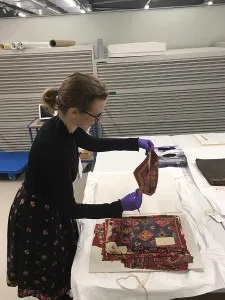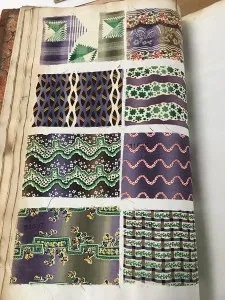Summer Research Report: Courtney Wilder

Courtney examining textile samples at the National Museums of Scotland in Edinburgh.
While many Decorative Arts Trust Summer Research Grants focus on American topics or US-based collections, recipients occasionally venture further afield. Courtney Wilder, a PhD Candidate at the University of Michigan, is exploring why an increasingly novel array of designs appeared in printed textiles and wallpaper in France and Britain between 1750 and 1850. She is particularly interested in the correlations between technology, science, printmaking, and the decorative arts. Her research took her to Scotland to scour archival and museum collections in Edinburgh and Glasgow.
“My dissertation considers the increasingly bold, abstract and colorful designs that emerged for printed dress fabrics in France and Britain from the early 1820s through the 1840s. I aim to take more seriously designs that have hitherto been dismissed as wildly eccentric, aesthetically unappealing, and ‘merely novel.’ This summer I investigated a question posed by the Journal of Design and Manufactures in July 1849, in response to a printed textile design submitted for review by the Glasgow printer James Black & Co. It did not suit the tastes of the anonymous editor (probably the design reformer Henry Cole), who describes it as showing, ‘An essentially ‘Scotch’ taste.’ He then asks, ‘Wherever do they get their designs from?’

Scottish textile design samples in the archives of the National Archives at Kew, London. Photo courtesy of Courtney Wilder.
“The Decorative Arts Trust provided me with funding to study Scottish designs from this period, and I spent two weeks in Glasgow and Edinburgh during June. The literature on Scottish textiles has been dominated by studies of plaids, paisley shawls, and turkey red printed fabrics. I found fewer extant pattern books and garments showing the more eccentric styles than I expected, but did see some fascinating examples of relevant designs in the special collections of the National Museums of Scotland in Edinburgh. The examples reaffirmed my sense that the products of top Scottish firms like James Black & Co. seemed to be aesthetically in-line with those of cutting edge British and especially French producers.
“In the special collections of Strathclyde University I learned more about how the industrial culture of Glasgow during this period was linked to a thriving intellectual culture. Educational establishments like Anderson’s Institute stocked wide-ranging lending libraries; industrial exhibitions introduced the public to the newest textile technologies; and campaigns sought to give designers free access to the city’s botanical gardens. Moreover, the men heading the city’s textile printing firms were far from parochial. This factor became especially apparent in the Crum Family papers at the Mitchell Library, which offer a fascinating window into the career of the textile printer Walter Crum of Thornliebank. Beginning with his apprenticeship in Manchester, Crum’s journals and letters reveal a man who read widely, studied arduously, and subsequently published his own theories on optics and chemistry. He traveled abroad for extended periods of time, and in 1855 became a Chevalier de la Legion D’honneur.

A daguerrotype portrait of textile printer Walter Crum, Mitchell Library, Glasgow.
“If there is an ‘essentially Scotch taste,’ I now think it is reflective of a widespread understanding in Glasgow and Edinburgh that science and industry were not separate from or antithetical to culture. This sensibility manifested in a pronounced openness to embracing novel forms of design, fashion, and visual art. My visit coincided with an exhibition at the Scottish National Portrait gallery called Hill & Adamson: A Perfect Chemistry. The pair’s photographic portraits reveal, unusually, female sitters wearing dresses made from a variety of the types of technologically cutting-edge printed materials in which producers like James Black and Walter Crum specialized. I was able to study further examples in the Gallery’s research library. The exhibition title sums up nicely the impression that this summer’s research fostered: the industrial and scientific cultures of Glasgow and Edinburgh represent a ‘perfect chemistry’ in which the international style of chemically and graphically experimental textile design found creative adaptations by enthusiastic producers and consumers.”
The enthusiastic support of Decorative Arts Trust members in 2017 supported Courtney and more than 50 additional students, emerging professionals, and institutions in the decorative arts field. We look forward to providing as many important opportunities in 2018 and beyond!
About The Decorative Arts Trust Bulletin
Formerly known as the "blog,” the Bulletin features new research and scholarship, travelogues, book reviews, and museum and gallery exhibitions. The Bulletin complements The Magazine of the Decorative Arts Trust, our biannual members publication.







